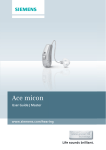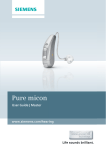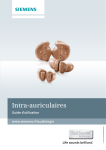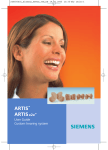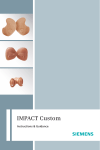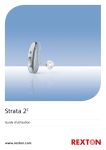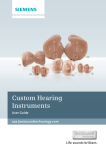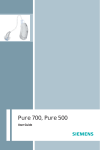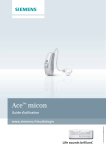Download Siemens Motion Custom User guide
Transcript
Motion Custom User Guide 2 Content Content Your Motion Custom hearing instrument 4 Intended use 6 General notes on safety 7 Handling batteries 10 Inserting and removing the hearing instrument 12 Turning your hearing instrument on and off 13 Changing the hearing program 14 Changing the volume 15 Functionalities 16 Maintenance and care 19 Accessories 21 Troubleshooting 22 Technical information 23 Disposal information 25 Your hearing instrument configuration 26 3 Your Motion Custom hearing instrument Your Motion Custom hearing instrument ITE (battery type: 13 or 312*) CT / ITC / HS (battery type: 312 or 10*) ⑤ Volume control ① Battery compartment (optional) ② Microphone ⑥ Vent ③ Second Microphone TwinMicTM (optional, not for CIC) ⑦ Removal cord (optional) ④ Program button (optional) Each hearing instrument can be identified by the serial number located on the outside of the instrument. * Ask your Hearing Care Professional. 4 Your Motion Custom hearing instrument EN CIC (battery type: 10) 5 Intended use Intended use Hearing instruments are intended to improve the hearing of hearing impaired persons. Diagnosis and prescription of a hearing instrument must be performed by hearing health specialists, e.g. ENT doctors, audiologists or acousticians. Read and follow the instructions of this user guide to avoid injuries or damage to the hearing instruments. Symbols: Be aware to information marked with the warning symbol WARNING, CAUTION or NOTICE! WARNING points out a situation that could lead to serious injuries, CAUTION indicates a situation that could lead to minor and moderate injuries. NOTICE NOTICE indicates possible property damage. Advice and tips on how to handle your device better. Instruction. Indicates that something has to be done. Indicates an option that not every hearing instrument has. Ask your Hearing Care Professional to check off the relevant information. 6 General notes on safety General notes on safety EN NOTICE Your hearing instruments are sensitive to extreme heat, high humidity, strong magnetic fields (> 0.1T), X-rays and mechanical stress. Do not expose your hearing instruments to extreme temperature or high humidity. Do not leave them in direct sunlight. Do not wear them in the shower or when you apply make-up, perfume, aftershave, hairspray or suntan lotion. Do not wear your hearing instruments when you are exposed to short-waves, a strong magnetic field, a high frequency field or X-rays. Do not place your hearing instruments in a microwave oven. 7 General notes on safety WARNING Choking hazard posed by small parts. Keep hearing instruments, batteries and accessories out of children‘s reach. If swallowed consult a physician or hospital immediately. This hearing instrument is not designed for children under the age of 36 months or mentally disabled persons. For suitable products please refer to your Hearing Care Professional. Siemens offers special hearing instruments for the fitting of infants and small children. Ask your Hearing Care Professional for further information. NOTICE Leaking batteries damage the hearing instruments. Turn the hearing instruments off when not in use to preserve the battery. Remove batteries when the instruments are not in use for a prolonged period of time. 8 General notes on safety EN NOTICE Batteries contain harmful substances that pollute the environment. Do not throw used batteries into household trash. Dispose batteries according to national regulations or return them to your Hearing Care Professional. In some countries restrictions for the usage of wireless equipment exist. Refer to local authorities for further information. WARNING Hazard of explosion! Do not use your hearing instruments in areas where there is a danger of explosions (e.g. mining). 9 Handling batteries Handling batteries original size Always use the right size batteries. Remove the tab on your batteries only when you are ready to use them. The positive (+) side of the batteries is always the smooth side. Always keep spare batteries with you. In some types of instruments the sounds may become fainter or you may hear additional sounds. This means that the battery power is low. If this happens, change the battery. 10 Handling batteries EN Low battery indicator Your Hearing Care Professional can activate an acoustic signal to inform you when the battery is nearly empty. If you hear an acoustic signal or experience low amplification power, replace the battery. Open the battery compartment. Insert the battery. Make sure the “+” symbols on the battery and compartment are aligned. Close the battery compartment. 11 Inserting and removing the hearing instrument Inserting and removing the hearing instrument Never pull on the battery compartment door or volume control wheel to remove the hearing instrument, as this could cause damage. Inserting Insert the hearing instrument into the ear canal. Slightly twist and push the hearing instrument into its proper position. Removing Push lightly on the back of your ear to loosen the hearing instrument. Pull the hearing instrument out. 12 Turning your hearing instrument on and off Turning your hearing instrument on and off Ask your Hearing Care Professional to check off the relevant information. Via battery compartment Fully open the battery compartment to turn your hearing instrument off. Fully close the compartment to turn your hearing instrument on. Via program button Press and hold the button for 3 seconds to turn the instrument on or off. Via volume control with on/off-function Rotate the colume control down to the stop to turn your hearing instrument off. Rotate the volume control up to turn your hearing instrument on. Via remote control Refer to the remote control user guide. Power-on delay Your hearing instrument is equipped with a "power-on delay" feature which can be activated by your Hearing Care Professional. This allows you to turn the hearing instrument on with an automatic delay of 6/12/18 seconds, so that you may insert the hearing instrument into your ear without experiencing unpleasant feedback (whistling). 13 EN Changing the hearing program Changing the hearing program Ask your Hearing Care Professional to check off the relevant information. Via program button Press the button to change the program. Via remote control Refer to the remote control user guide. 14 Changing the volume Changing the volume EN The volume of your hearing instruments is controlled automatically and there is no need to manually adjust it. Should you prefer manual volume control, your Hearing Care Professional can program the hearing instrument for manual adjustment. Automatic The volume is adjusted automatically when in use. Via volume control Rotate the wheel forward for louder. Rotate the wheel back for quieter. Via remote control Refer to the remote control user guide. 15 Functionalities Functionalities Your Hearing Care Professional can activate the following functionalities. e2e wireless ■ Allows the use of a remote control. ■ Automatically adjusts both hearing instruments simultaneously to change the instrument settings, e.g. volume or program. The performance of the e2e wireless function may be affected by electromagnetic interference – e.g. from a computer monitor or fluorescent lamp system. Move away from the source of interference if you experience difficulty. Automatic telephone program Hold a telephone near your hearing instrument (*). The hearing instrument automatically switches to the telephone program. Move the telephone away from your hearing instrument. The hearing instrument switches back to the previously used program. 16 Functionalities EN You can also select the telephone program manually by using the program button. When operating the hearing instrument in telecoil mode, the wireless function may cause a pulsing noise. In this case use the remote control with a distance greater than 10 cm (4 inches). (*) AutoPhone magnet accessory Not all telephones produce a magnetic field strong enough to activate the AutoPhone function. In this case, use the Siemens AutoPhone magnet, which is available as accessory, and attach it to the telephone receiver to activate the AutoPhone function. See the AutoPhone magnet user guide for instructions on how to position the magnet. Use only the Siemens magnet. Ask your Hearing Care Professional for this accessory. NOTICE Magnets can disturb electrical devices and delete stored data. Keep magnets away from computers, color monitors, television sets, floppy discs, videoand audio discs and other electronic equipment/ devices. 17 Functionalities WARNING Magnets may interfere with the operation of life supporting systems (e. g. pacemakers, magnetic valves). Use a magnet only if not in doubt about the safe distance. The safe distance between pacemaker and magnet should be at least 10 cm (4 inches). 18 Maintenance and care Maintenance and care EN Your hearing instruments are highly sensitive systems. Proper care and handling will ensure the best possible performance. Clean instruments regularly to prevent damage to the hearing instruments and to avoid health problems. NOTICE Do not put the hearing instruments in water. Clean your hearing instruments with a soft, dry tissue, as necessary. Do not use alcohol or other solvents as it will damage the instruments. Be careful not to damage the wax protection when cleaning the hearing instruments. Place your hearing instruments in a "dry aid kit" with a special moisture-attracting capsule overnight. If the windscreen of your hearing instruments is soiled, ask your Hearing Care Professional to clean or exchange the windscreen. Ask your Hearing Care Professional for special care sets and further information on how to keep your hearing instruments in good condition. 19 Maintenance and care Wax protection Your hearing instruments are equipped with a sieve, recess or guard on the sound outlet to prevent earwax from entering the hearing instruments. Your Hearing Care Professional will provide you with the wax protection appropriate for your instruments and can advise you how to clean or replace it. If the instruments sound distorted or weak exchange the wax protection. 20 Accessories Accessories EN Tek wireless enhancement (not all hearing instruments) Your hearing instruments together with the Tek Connect remote control will allow you to connect your hearing instruments to the growing world of technology. Via a special Bluetooth connection it is possible to receive audio signals from your mobile, your television or your mp3-player. For detailed information and instructions refer to the Tek user guide or ask your Hearing Care Professional. Remote control (not all hearing instruments) The wireless function of your hearing instruments allows you to use a remote control to change the program and volume of your hearing instruments. For further information about the remote control, contact your Hearing Care Professional or refer to the remote control user guide. In the event your hearing instruments can be controlled by another person's remote control, return hearing instruments and remote control to your Hearing Care Professional. 21 Troubleshooting Troubleshooting Use these tips to resolve simple issues. Problem Possible solution Sound is weak. Replace empty battery. Increase volume. Clean instrument. Close battery door completely or press and hold the program button for approximately 2 seconds. Hearing instrument Reinsert the instrument until it fits securely. emits whistling sounds. Clean instrument. Sound is distorted. Replace empty battery. Lower volume. Clean instrument. Hearing instrument Gently close battery compartment emits signal tones. completely. Replace empty battery. Hearing instrument Check if the hearing instrument is does not work. turned on. Gently close battery compartment completely. Replace empty battery. Make sure battery is inserted correctly. Power-on delay is active – wait 18 seconds and check again. Consult your Hearing Care Professional if you encounter further problems. 22 Technical information Technical information EN Siemens Motion 700 WL, Motion 500 WL, Motion 300 WL Siemens Motion 701 WL, Motion 501 WL, Motion 301 WL FCC ID: SGI-WL002ITE IC: 267AB-WL002 Operating frequencies: Fc=3.28 MHz N14203 This Class B digital apparatus complies with Canadian ICES-003. Changes or modifications made to this equipment not expressly approved by SAT GmbH for compliance may void the FCC authorization to operate this equipment. FCC compliance This device complies with Part 15 of the FCC Rules and with RSS-210 of Industry Canada. Operation is subject to the following conditions: ■ this device may not cause harmful interference, and ■ this device must accept any interference received, including interference that may cause undesired operation. This equipment has been tested and found to comply with the limits for a Class B digital device, pursuant to Part 15 of the FCC Rules. These limits are designed to provide reasonable protection against harmful interference in a residential installation. This equipment generates, 23 Technical information uses and can radiate radio frequency energy and, if not installed and used in accordance with the instructions, may cause harmful interference to radio communications. However, there is no guarantee that interference will not occur in a particular installation. If this equipment does cause harmful interference to radio or television reception, which can be determined by turning the equipment off and on, the user is encouraged to try to correct the interference by one or more of the following measures: ■ Reorient or relocate the receiving antenna. ■ Increase the separation between the equipment and receiver. ■ Connect the equipment to an outlet on a circuit different from that to which the receiver is connected. ■ Consult the dealer or an experienced radio/TV technician for help. 24 Disposal information Disposal information EN Within the European Union, the marked equipment is covered by "Directive 2002/96/EC of the European Paliament and of the Council of 27 January 2003 on waste electrical and electronical equipment." Amended by "Directive 2003/108/EC" (WEEE). Recycle hearing instruments, batteries and ac- cessories according to national regulations. With the CE marking Siemens confirms compliance with the European Directive 93/42/EEC concerning medical devices. For the products with e2e wireless 2.0 Siemens additionally confirms compliance with the European Directive 99/5/EC (R&TTE) concerning radio and telecommunications terminal equipment. 25 Your hearing instrument configuration Your hearing instrument configuration LEFT Hearing instrument RIGHT Model Serial number Battery □ yes □ no Power-on delay □ yes □ no □ yes □ no Volume control □ yes □ no □ yes □ no Push button □ yes □ no Signal tones □ on □ off Low battery warning □ on □ off □ on □ off Volume control limit □ on □ off □ on □ off volume control change □ on □ off Hearing program Description of the hearing program 1 2 3 4 5 Remote control Model Serial number 26 © Siemens AG, 07.2011 · ANR Document No. A91SAT-00673-99T6-7600 Order/Item No. 104 202 05 Printed in Germany Siemens Audiologische Technik GmbH Gebbertstrasse 125 91058 Erlangen Germany Phone +49 9131 308 0 www.siemens.com /hearing




























